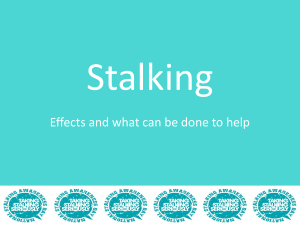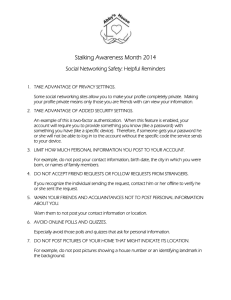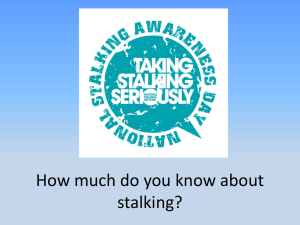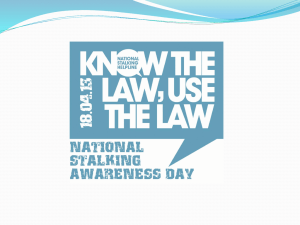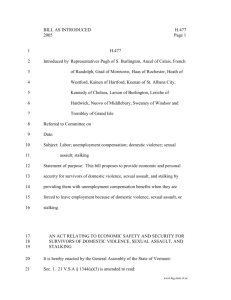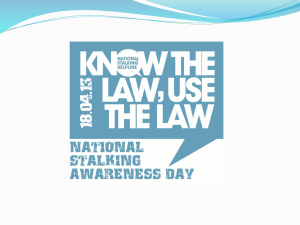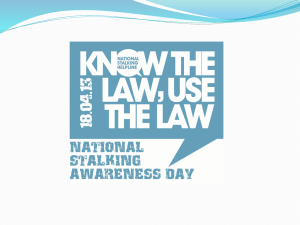stalking - Forensis.org
advertisement
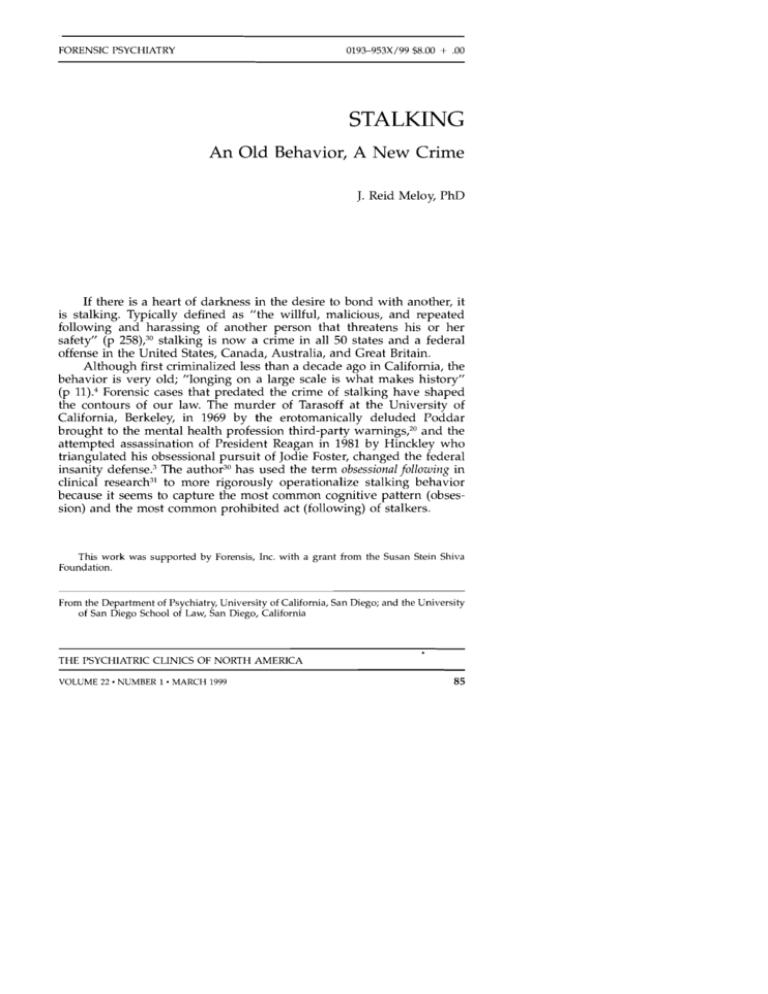
FORENSIC PSYCHIATRY 0193-953X/99 $8.00 + .00 STALKING An Old Behavior, A New Crime J. Reid Meloy, PhD If there is a heart of darkness in the desire to bond with another, it is stalking. Typically defined as "the willful, malicious, and repeated following and harassing of another person that threatens his or her safety" (p 258),30 stalking is now a crime in all 50 states and a federal offense in the United States, Canada, Australia, and Great Britain. Although first criminalized less than a decade ago in California, the behavior is very old; "longing on a large scale is what makes history" (p 11).4 Forensic cases that predated the crime of stalking have shaped the contours of our law. The murder of Tarasoff at the University of California, Berkeley, in 1969 by the erotomanically deluded Poddar brought to the mental health profession third-party warnings,2° and the attempted assassination of President Reagan in 1981 by Hinckley who triangulated his obsessional pursuit of Jodie Foster, changed the federal insanity defense. 3 The author30 has used the term obsessional following in clinical research3 ! to more rigorously operationalize stalking behavior because it seems to capture the most common cognitive pattern (obses­ sion) and the most common prohibited act (following) of stalkers. This work was supported by Forensis, Inc. with a grant from the Susan Stein Shiva Foundation. From the Department of Psychiatry, University of California, San Diego; and the University of San Diego School of Law, San Diego, California THE PSYCHIATRIC CLINICS OF NORTH AMERICA VOLUME 22 • NUMBER 1 • MARCH 1999 85 86 MELOY EPIDEMIOLOGY The Center for Policy Research45 conducted a random probability telephone survey of 16,000 men and women in the United States, and, using a carefully constructed and behaviorally defined series of ques­ tions, found that 8% of adult women and 2% of adult men have been stalked sometime in their lives. One percent of women and 0.4% of men reported being stalked in the past year. Approximately half of the victims report the stalking to the police, but a criminal prosecution results in only one of five reported cases. Stalking and other noncriminal forms of obsessional following seem to be major public health and social prob­ lems in Westernized, developed countries. Stalking behavior in other countries has yet to be measured. DEMOGRAPHY The modal stalker is an unemployed or underemployed man in his fourth decade of life. He is single or divorced and has a prior criminal, psychiatric, and drug abuse history. He has a high school or college education, however, and is significantly more intelligent than are other criminals. 23 He does not disproportionately appear in any racial or ethnic group. Suggestive datal? show that he suffered the loss of a primary caretaker in childhood and a significant loss, usually a job or relation­ ship, within a year of the onset of stalking. This crime seems to be, in part, a pathology of attachment. 22 The modal stalking victim is a woman younger than her pursuer, with whom she had a prior sexually intimate relationship. If a man is stalked, the stalking is likely done by a man who was a prior acquain­ tance or stranger. Homosexual males are at significantly greater risk of being stalked than are heterosexual males. 45 The most useful offender-victim typology for classifying stalking cases has been developed by Zona and his colleagues. 48,49 They divided stalking cases into four groups: 1. The erotomanic, representing approximately 10% of stalking cases, is marked by a primary diagnosis of delusional disorder, erotomanic subtype, and is typically a woman pursuing a male stranger. Duration is the longest (> 1 year) of the four groups of stalking, and violence risk is the lowest among the groups. 2. The love obsessional, representing approximately 30% of stalk­ ing cases, is marked by a variety of psychiatric diagnoses and is typically a man pursuing a female acquaintance or stranger. There is a fanatical love toward the subject, and if there are erotomanic beliefs, they are secondary to a major mental disorder. 3. The simple obsessional, practiced by most stalkers (> 50%), is marked by drug dependency or abuse and a personality disorder and is typically done by a man who has been rejected when STALKING 87 pursuing a prior sexually intimate woman or another nonsexual relationship (e.g., workplace supervisor). Duration is the shortest « 1 year), and violence risk is the highest among the groups. 4. False victimization syndrome, displayed by approximately 2% of cases, is marked by the victim's allegation of stalking by a known or unknown perpetrator, when, in fact, he or she is not being stalked. Often, an Axis II, Cluster B personality disorder diagnosis is made, and the motivation may be conscious (an alibi), subconscious (attention seeking), or delusional (persecu­ tion).34 PSYCHIATRIC DIAGNOSES Most stalkers have both Axis I and Axis II diagnoses. The most common Axis I diagnoses, in descending order of frequency, are drug abuse or dependence (e.g., alcohol or stimulants), a mood disorder, or schizophrenia. One study42 identified organic impairments in half of a small, incarcerated sample of stalkers. Only one in five stalkers, however, is psychotic at the time of the pursuit and is usually motivated by a delusional belief that is directly related, such as erotomania, or obliquely tied, such as misidentification, to the victim. Psychotic stalkers are sig­ nificantly more likely to pursue a stranger or acquaintance than a person with whom he or she shared a prior intimate relationship.17, 23, 26, 31, 48, 49 Axis II diagnoses are most likely to be Cluster B (i.e., narcissistic, histrionic, antisocial, or borderline), with paranoid (Cluster A) and com­ pulsive (Cluster C) features not uncommon. In one large study, the modal Axis II diagnosis was personality disorder not otherwise speci­ fied. 31 Antisocial personality disorder, however, is less likely to be found among stalkers, usually at a frequency of 10%, than among other crimi­ nals, in whom frequencies usually exceed 60%.13,23 This replicated find­ ing empirically supports the theory that stalkers form intense, preoccu­ pied attachments to their victims/ I - 23 a biobehavioral pattern of bonding grossly opposite the chronic, emotional detachment of the antisocial, or, in the most severe cases, psychopathic, individual. lO PSYCHODYNAMICS The social context for stalking often seems to be chronic sexual mating failure, social isolation, loneliness, and a major lossY, 23, 26, 43 Embedded within this unpleasant, if not painful, social reality is a narcissistic character pathology that is organized at a borderline level of personality.16, 22 This psychology predicts certain defenses, emotions, and thoughts: splitting and its phenotypic variants, such as projection, projective identification, denial, idealization, and devaluation apparent (although the use of neurotic defenses, such as minimization and ration­ alization, at times, is not precluded)29; certain emotions, such as rage, 88 MELOY envy, jealousy, and shame, are easily stimulated, particularly when nar­ cissistic supplies and desires, such as attention or control, are denied or withdrawn; and thoughts are imbued with narcissistic linking fantasies in relation to desired objects, marked by beliefs that one is loved, admired by, or destined to be with a certain person. These linking fantasies may eventually provide the conscious preoccupations and de­ rivative rationalizations, usually marked by grandiosity and entitlement, that may excuse the stalking once it begins, particularly if competing superego constraints, such as guilt, remorse, or ambivalence, are present. Figure 1 illustrates the sequence of events, both internal and exter­ nal, that unfolds in many cases of stalking. There is, at first, a narcissistic linking fantasy toward an object that could be largely reality-based (e.g., an actual sexual mate) or delusional (e.g., an erotomanic belief concern­ ing a celebrity). Narcissistic linking fantasies may be normative39,40 and often form the basis of romantic pursuit, instilled with hope and the idealization of the future. They stimulate action in most, which may be greeted with acceptance or rejection by the real, desired object. If she reciprocates, an affectionate and sexual relationship may bloom; if she rejects, the normal reaction is hurt, anger, sadness, and grief, and the eventual search for another object with whom to bond. In the socially isolated and characterologically narcissistic world of the stalker, however, a more ominous course of events unfolds. Rejection stimulates shame and humiliation, the sensitive, ventral underbelly of pride, which is quickly defended against with rage-not anger-toward what Kohut 19 would view as a self-object and Kernberg 16 would see as a part-object. The perception is one of abandonment or disillusionment, and defenses constellate around these emotions, such as the devaluation of the rejecting object to maintain rage (e.g., "That bitch deserves to die") and diminish envy (e.g., "She is just a cum catcher"). The latter Narcissistic linking fantasy: special, loved, idealized, admired by, superior to, destined to be with the object Feelings of shamelhumiliation Defended against with rage Fuels behavioral pursuit: To hurt, 10 control. to damage or destroy Restores narcissistic linking fantasy Figure 1. Pattern followed by many stalkers. STALKING 89 emotion, prominent in narcissistic psychopathology, is the wish to pos­ sess the goodness of another. 18 If she is sufficiently devalued, the stalker begins to see the victim as unworthy of having. These emotions fuel the pursuit of the object to hurt, injure, control, damage, or destroy him or her. The most paradoxic and disturbing aspect of stalking, however, is that the aggressive and destructive pursuit, if successful, restores the narcissistic linking fantasy; the damaging of the object in reality ushers in the awful flowering, once again, of these entitled, grandiose, and "perfect" beliefs. Shakespeare captured this dynamic when he had Othello speak the words, "I will kill thee, and love thee after" (Othello, V, ii, 17, 18). Simpson did, too, when he spoke more than 3 years after he was charged with killing his ex-wife, Brown-Simpson: "Let's say I committed this crime.... Even if I did do this, it would have to have been because I loved her very much, right?" (Esquire, February 1998, p.58). There is a growing body of empiric work that supports these theo­ retic and clinical findings. Toch46 studied humiliating affronts and their close relationship to anger in violent men, and Novac0 37 studied how anger serves as an overriding function to keep less tolerable emotions out of consciousness. Anger, jealousy, abandonment rage, and a need for power and control are common motivations identified in clinical studies of stalkersY' 30, 31 Inferred defenses, based on clinical observa­ tions, include most prominently minimization, denial, projection of blame, and projective identification. 31 In one study,3! 31 % of a sample of stalkers (n = 65) reported preoccupations involving interpersonal con­ trol to the evaluating clinicians. The most likely perceived goal of stalk­ ers by victims of stalking, moreover, is to control them. 45 Domestically violent men, who may be at greater risk for stalking if estrangement occurs, show significant correlations between feelings of humiliation in research paradigms and reports of being verbally abused by his mother as a child? And finally, narcissistic psychopathology is rampant among obsessional followers in particular,26 and antisocial individuals in gen­ eral. lO PURSUITS AND OUTCOMES Stalking is a chronic behavior that unfolds over the course of months or years. Tjaden and Thoennes 45 found the average length of stalking to be 1.5 years in their large, random telephone survey of victims. Earlier research 22 ,48 documented the length of obsession in erotomanic subjects to average 5 to 10 years. Although cases usually begin with what have been called "obsessive relational intrusions"44 and may not escalate to criminal stalking, any repetitive harassing behavior that threatens the victim's safety should warrant concern. Stalking typically commences with unwanted telephone calls or physical approaches, usually to a place the victim frequents; these behav­ 90 MELOY iors continue to be the most common methods of pursuit (although electronic means, such as e-mail, are gaining prominence) but may initially be perceived by the victim as only peculiar or inappropriate. Verbal limit-setting, however, is ineffective, and rejection is either grossly misinterpreted or stimulates anger toward, and devaluation of, the vic­ tim by the pursuer. In one case involving a 29-year-old erotomanic man, rejection by the female victim, with whom he had only a few brief conversations in a bar, was perceived by the stalker to mean that she was protecting him from something and that she was at imminent risk. This paranoid delusion, buttressed by ideas of reference from television (i.e., The X Files, a fictional paranoid conspiracy involving aliens, para­ normal experiences, and FBI agents) and radio eventually resulted in a homicidal assault 2 weeks later at the Ford assembly plant outside Detroit, Michigan, where she worked. One manager was killed, and two police officers were wounded (People v. Gerald Atkins, Circuit Court for the County of Oakland, Case No. 97-155349 FC). The emotional consequences of stalking on the victim are severe and prolonged. Pathe and Mullen38 studied a nonrandom clinical sample of Australian stalking victims (n = 100) and reported that most had intrusive recollections and flashbacks, while nightmares, appetite distur­ bances, depressed mood, and suicidal thoughts were common. Thirty­ seven percent met criteria for posttraumatic stress disorder. 1 Hall 12 found in her national telephone survey of stalking victims (n = 145) that they became significantly more aggressive, paranoid, easily frightened, and cautious of others following the crime. Tjaden and Thoennes 45 reported that one third of the women and one fifth of the men in their random telephone interviews (n = 16,000) sought psychological help if they were stalked and were significantly more likely than those who had not been stalked to be very concerned about their personal security and to carry something to defend themselves. These three studies of stalking victims across two continents indicate that psychiatric sequelae of the crime are severe, diagnosable, and, in some cases, disabling. THREATENING COMMUNICATIONS A threat is a written or oral communication that implicitly or explic­ itly states a wish or intent to damage, injure, or kill the target. A review of the existing research on threats in stalking and targeted violence 27 indicates that threatening communications occur in most cases of stalk­ ing, usually at a rate of 50% to 75%; most individuals do not act on their threatening communications, generating false-positive rates of approxi­ mately 75%; threats may increase, decrease, or have no relationship to the risk for subsequent violence; a few individuals are violent but do not threaten, generating false-negative rates of 10% to 15%; and threats are either instrumental or expressive. Instrumental threats are primarily intended to control or influence the behavior of the target through an aversive consequence. Expressive STALKING 91 threats are primarily used to regulate affect in the threatenerY For example, in one case, a spouse with antisocial personality disorder instrumentally threatened that if his wife left him, he "would bag her," a homicidal threat that succeeded in keeping her in the physically and sexually abusive relationship for years. 24 When she did leave him, he kept his word. In another case, a psychotherapy patient expressively threatened to kill his boss in the doctor's waiting room following a treatment session. His psychologist overheard him, questioned him care­ fully, and correctly determined that it was an expressive threat and that no third-party warning was necessary. He was not subsequently violent. Threatening communications also suggest certain psychological de­ fenses, such as devaluation (e.g., "The whore deserves to die."), projec­ tion (e.g., "She threatened me"), minimization (e.g., "I was just teasing her"), and denial (e.g., "I didn't threaten her"). A careful analysis of the type of threat, whether instrumental or expressive, and the defensive use of the threat can help the forensic clinician discern the state of mind of the threatener and the concordant risk. Limitations to threat research exist, however. No published studies, as yet, find that threatening communications account for any of the explainable variance in assessing violence risk, and in certain groups of stalkers and threateners, the threat data are counterintuitive. Dietz et alS,6 found that threatening communications in letters had no relationship to approaching Hollywood celebrities and an inverse relationship to approaching US congressmen, Fein and Vossekuil 8 reported in a large sample of attackers, near attackers, and assassins of public figures (n = 83) that less than 10% communicated a direct threat to the target or law enforcement before the violent incident. VIOLENCE Personal violence is an intentional act of aggression that physically injures, or is likely to injure, another person. This article distinguishes personal violence from property violence, where the intent is to damage or destroy an inanimate object. The relationship, moreover, between stalking and violence has been researched during the past decade. De­ spite histrionic displays by the American commercial media to fit every stalker into the Procrustean bed of a homicidal psychopath, most do not. The most valid and reliable finding in the research is that most stalkers are not violent, and, when they are, the physical injury to the victim is not severe.23. 31 Nonetheless, the frequency of personal violence among stalkers is still high and deserves continued clinical and research attention. A sampling of recent studies in Table 1 is notable given the fact that personal violence is not a legal element in any state or federal stalking law. The likelihood of physical attack is high even though the degree of physical injury is relatively low. The psychological impact of violence, moreover, is not accounted for in these studies and may result in what 92 MELOY Table 1. RECENT DATA ON PERSONAL VIOLENCE IN STALKING CASES Study Mullen and Pathe (1994)'" Meloy and Gothard (1995)3() Harmon et al (1995)'" Garrod et al (1995)" Kienlen et al (1997))7 Schwartz-Watts et al (1997)42 Meloy et al (submitted) Sample Location 14 cases Australia California New York British Columbia Missouri South Carolina California 20 48 100 25 18 65 cases cases cases cases cases cases Personal Violence Frequency 36% 25% 21% 0%-42% 32% 39% 40% Aggregate sample = 290 cases. van der Kolk47 described as "the loss of faith that there is order and continuity in life" (p 47). The author has found in his research 30. 31 that stalkers, if violent, usually grab, choke, pull the hair of, throw, shake, hit, slap, kick, fondle, or punch the victim. A weapon-usually a handgun, knife, or automobile-is suggestively used by the stalker in only one of three cases when violence occurs. In one study,31 the victims were never shot by the gun, cut by the knife, or hit by the car of the stalker. Weapons are generally used by stalkers to intimidate and control, rather than physically injure, their victims. Homicide in stalking cases seems to be rare, probably occurring in less than 2% of cases. 23 It is important to recognize, however, that this rate is still more than 200 times the rate of homicide risk for nonstalked persons living in the United States. This statistic, moreover, may be an underestimate because the crime of stalking may not be charged in homicide cases when it precedes the murder of the victim. There are also suggestive findings in the domestic violence research that stalking behavior is a serious lethality risk factor in spousal homicide by es­ tranged male partners (A. Browne, personal communication, April 1998). Research on the relationship between the stalking and killing of es­ tranged spouses has yet to be done. The nature of stalking violence is affective rather than predatory25. 33 when the victims are prior sexual mates. Affective violence is an emo­ tional reaction to a perceived threat-in stalking cases, this is usually rejection-and is accompanied by quite elevated, autonomic arousal. Predatory violence is planned, purposeful, and emotionless, without evidence of autonomic arousal. Although there are relatively high rates of false-negatives in stalking violence (i.e., assaults without a prior threat), the violence in these cases seems to be impulsive, reactive, and highly emotional rather than a planned surprise attack. When predatory violence occurs in stalking cases in the absence of a direct threat, the • targets are likely to be public figures or public officials. 8 Violence toward third parties occurs in less than 20% of stalking STALKING 93 cases and is usually directed at individuals perceived to be impeding access to the objecF3 Although such assaults are the exception to the rule, they do command attention. Robert Hoskins, an itinerant man who stalked Madonna for 2 months in 1995, eventually assaulted, and was shot by her bodyguard, Basil Stephens, whom he believed was keeping him from seeing "his wife. 1125, 41 This social dynamic, which the author calls triangulation, may increase the risk for violence in cases of stalking. It may be delusional, as the author noted earlier in the People v. Atkins case, or it may be actual interference by a third party, as was seen in the Hoskins case. The psychodynamic seems to be a displacement of rage (projectively experienced as paranoia) felt toward the rejecting object onto a third party, which protects the idealization of the object, but at the expense of stimulating persecutory fears of attack from others. 27 This may increase a sense of magical connectedness to persecutory objects2 but also may increase feelings of fearful vulnerability. It may result in a preemptive strike, often rationalized by the stalker as rescuing. Atkins told the police interrogators, "I wanted to ask her to marry me and it was like she was trying to avoid me for some reason. Like she was trying to avoid me to protect me from something and I wasn't sure what that was.... I would not let anybody ever, ever infringe on her rights (Police interrogation, Nov. 18, 1996). Property violence in stalking cases is substantial but is less likely to occur, arguably at half the rate, than is personal violence toward the target. Objects damaged are usually owned by the victim, such as an automobile, or symbolically represent the victim, such as clothing or a personal photograph. The violence is usually affective, but when preda­ tory violence toward property does occur, it is purposefully done to frighten, immobilize, or invade the privacy of the victim. Only one published study has attempted to predict violence among erotomanics. Menzies et aP2 combined a small Canadian sample of hospitalized erotomanic males (n = 13) with reports of erotomanic men in the English language psychiatric literature (n = 16). Dangerous behavior, defined as threats or violence toward the object(s) of pursuit, was accurately predicted in 88.9% of cases by the presence of two variables: (1) multiple, concurrent objects of pursuit and (2) unrelated serious antisocial behavior, usually a history of violence convictions. Notwithstanding the serious methodologic problems of this study, such as the combining of two very disparate groups, this is the first predictive attempt in the literature. Clinicians should rely on established risk factors in violence assess­ ment,35 particularly those found in mentally ill offenders 15 given the high rates of Axis I disorders and prior criminality among stalkers. II CLINICAL RISK MANAGEMENT The author has proposed 10 guidelines for the clinical risk manage­ ment of stalking cases and summarizes them here. 25 In all cases of 94 MELOY stalking, a team approach is preferred. Usually, the team includes the victim, an emotionally supportive companion; a mental health profes­ sional; a local police officer familiar with the case; a local prosecutor; and, in some cases, a private attorney and private security guard or investigator. Although economics may limit the size and combined expe­ rience of the team, most of these professionals are often available through the public sector and are funded by tax revenues. A coordinator is mandatory, and even though law enforcement does not get involved until they have probable cause to believe a crime is being committed, teamwork should be the method of operation to pursue the safety of the victim. It is imperative that the clinician repeatedly underscore to the victim that he or she is primarily responsible for his or her personal safety. The patient will likely respond to these confrontations with a variety of emotions and resistance, but the psychotherapist should not relent. The goal is to penetrate the victim's idealizations of the police, usually imbued with positive, paternal transferences, that they have the omnipo­ tence to protect him or her from harm at all times. This does not mean, however, that he or she is responsible for being stalked, nor that he or she must go it alone. In fact, helping him or her recognize the reality basis of his or her fears may free him or her to actively pursue available resources to improve the physical security of his or her environment and the safety of his or her daily activities. One of the key, proactive steps in risk management is documenta­ tion and recording of all incidents involving the stalker. The victim should carefully note each event (i.e., date, time, place, and behavior) in a daily log and keep any tangible proof of its occurrence, such as photos, audiotapes, and videotapes, letters, facsimile transmissions, printed E­ mail, unwanted gifts, and any inappropriate or frightening items (one stalker often left red roses in dirty, used soda containers on the doorstep of his victim). Careful documentation also establishes evidence of a course of conduct in a stalking case that may be central to convincing the judge or jury that the victim had good reason to be fearful; the context of the item often establishes the emotion it will evoke. Perhaps the most common mistake that stalking victims make is to initiate personal contact with the stalker. This behavior is usually driven by guilt, kindness, anger, or fear but is a misguided attempt to reason with an unreasonable individual. In all cases, it serves as an intermittent positive reinforcer for the stalker and will likely increase his or her subsequent approach behavior. Initiated contact is most problematic during the trial of stalking cases because the state often has to demon­ strate reasonable fear in the victim through her testimony, and the defendant has a constitutional right, at least in the United States, to confront his or her accuser. The psychodynamics of stalking and legal procedure clash head-on as the stalker finally achieves in the courtroom what he or she has been trying to do for months or years: get.close to STALKING 95 his or her object of pursuit. There is no simple answer to this conundrum other than to recognize the reinforcing impact on the stalker and the distress of the victim. One of the legal means to reduce contact and document the fear of the victim is the service of a restraining (protection) order. Although controversy surrounds their effectiveness, particularly in stalking cases, a thorough review of the 14 published studies of such orders indicates that in most cases, they effectively suppress the unwanted behaviorY In a random predictive study of domestic protection orders over the course of 3 years, the author found that protection orders appeared to effec­ tively suppress criminal behavior toward protectees in more than 85% of cases (n = 200).28 The problem with the aggregate research in this area, however, is the virtual absence of studies focusing specifically on the effect of such orders on stalking behavior per se. The author recom­ mends that a risk-management decision to seek a protection order be based on four questions: 1. What has been the effect of a protection order in the past on this individual? 2. Is there a history of physical violence toward the protectee? 3. How preoccupied or obsessed with the protectee is the individ­ ual? 4. How aggressive are the local police in enforcing protection or­ ders, and how coordinated is the judicial response to such viola­ tions? Failure to obey a past order, prior physical violence, intense preoccupa­ tion with the victim, and poor enforcement all predict violations of the protection order by the stalker. Law enforcement and prosecution of stalking cases is based on the police determining that a crime has been committed and the prosecution believing that evidence exists to convince the trier of fact beyond a reasonable doubt that the defendent committed the crime. These increas­ ingly higher standards of proof require that clinicians involved in such cases be both patient and tenacious in their contacts with peace officers and prosecutors. Police should first be summoned whenever more than one unwanted intrusion stimulates anxiety, anger, or fear in the victim. The victim should insist, despite any hesitancy of the responding officer, that an incident report be filed. Treatment is also a necessary component of stalking cases for both the victim and the perpetrator. Given the variety of diagnoses evident among stalkers,23 treatment should focus on the psychiatric or psycho­ logical cause of the behavior. 9 Treatment success varies. Axis I conditions most responsive to medication, such as paranoid schizophrenia, are likely to yield much better results than are Axis II personality disorders. Clinicians should remain sensitive to the likely presence of both an Axis I and Axis II disorder in a patient who has a history of stalkihg and 96 MELOY attempt to discern the condition that accounts for the stalking behavior. For instance, an individual with schizophrenia who has secondary eroto­ manic symptoms and also has dependent personality disorder may cease his or her stalking behavior but still remain dependent once the more florid psychotic symptoms are treated with a neuroleptic drug. On the other hand, an individual who is obsessed with the object of his or her pursuit and also has a diagnosable borderline personality disorder may respond nicely to medication and intensive psychotherapy. Paradoxi­ cally, the most treatable stalkers are likely to be pursuing casual acquain­ tances or strangers rather than prior sexual mates. 3 ! Even though antisocial personality disorder and its severe variant psychopathy are less frequent among stalkers than among other crimi­ nals, in certain cases segregation and incarceration should be the primary goal of clinical risk management. "Stalking is bad (antisocial) behavior done by mad (angry or psychotic, or both) people" (p 181),25 and in most cases both mental health and criminal justice responses are neces­ sary. One of the predictable outcomes of the stalking of celebrities, however, is that the prosecution and incarceration of the stalker may bring him or her notoriety that he or she had previously only achieved in private, grandiose fantasies. A periodic violence risk assessment is also necessary in stalking cases. Contemporary research in violence prediction indicates that both static and dynamic factors influence violent behavior. Static factors, such as age and history of violence, are not amenable to interventions, whereas dynamic factors, such as most Axis I diagnoses, are responsive to interventions. Dynamic factors may also change without intervention, such as the stalker's inclination to abuse stimulants on any particular day. Violence risk ebbs and flows, and, therefore, an assessment should be done periodically by a qualified forensic evaluator. It should be based on a clinical evaluation, historical and contemporaneous data independent of the stalker's self-report, and psychological testing, if fea­ sible. The final clinical risk-management guideline is the recognition of dramatic moments. These are events that humiliate the stalker, stoke his or her fury, and increase his or her risk for violence. They may include his or her first rejection by the victim; unacknowledged letters and gifts, contact by a third party admonishing him to cease his behavior, service of a restraining order, police contacts, court appearances, incarceration, conviction, or sentencing. Despite the feelings of justification and righ­ teousness by the victim during these moments of triumph for him or her, it is crucially important to not lose sight of the deep narcissistic wounding of the stalker at these same points. Victims of stalking may be at greatest risk for personal violence immediately following a dramatic moment if the stalker still maintains his or her freedom. STALKING 97 SUMMARY Stalking is an old behavior, but a new crime. The author has re­ viewed what is currently known about the epidemiology, demography, psychiatry, psychology, pursuits and outcomes, threatening communica­ tions, violence, and clinical risk management of stalking cases. But this "dark heart of romantic pursuit" (p 7)26 extends beyond the paradigm of science and is often an aggressive and aberrant expression of unre­ quited love. In 1579, John Lyly wrote"As the best wine doth make the sharpest vinegar, so the deepest love turneth to the deadliest hate" (Euphues: The Anatomy of Wit). References 1. American Psychiatric Association: Diagnostic and Statistical Manual of Mental Disor­ ders, ed 4. Washington DC, APA, 1994 2. Auchincloss EL, Weiss RW: Paranoid character and the intolerance of indifference. J Am Psychoanal Assoc 40:1013-1038,1992 3. Caplan" L: The Insanity Defense and the Trial of John W. Hinckley, Jr. New York, Dell, 1987 4. DeLillo D: Underworld. New York, Scribner, 1997 5. Dietz PE, Matthews D, Van Duyne C, et al: Threatening and otherwise inappropriate letters to Hollywood celebrities. J Forensic Sci 36:185-209, 1991 6. Dietz PE, Matthews D, Martell D, et al: Threatening and otherwise inappropriate letters to members of the United States Congress. J Forensic Sci 36:1445-1468,1991 7. Dutton D: The Domestic Assault of Women. Vancouver, University of British Columbia Press, 1995 8. Fein R, Vossekuil B: Preventing attacks on public figures and public officials: A Secret Service perspective. In Meloy JR (ed): The Psychology of Stalking: Clinical and Forensic Perspectives. San Diego, Academic Press, 1998, pp 175-194 9. Gabbard G (ed): Treatments of Psychiatric Disorders, ed 2, volland 2. Washington DC, American Psychiatric Press, 1995 10. Gacono CB, Mel~y JR: The Rorschach Assessment of Aggressive and Psychopathic Personalities. Hillsdale, Lawrence Erlbaum, 1994 11. Garrod A, Ewert P, Field G, et al: The Report of the Criminal Harassment Unit: The Nature and Extent of Criminal Harassment in British Columbia. Vancouver, Ministry of Attorney General, 1995 . 12. Hall D: The victims of stalking. In Meloy JR (ed): The Psychology of Stalking: Clinical and Forensic Perspectives. San Diego, Academic Press, 1998, pp 113-137 13. Hare RD: Manual for the Psychopathy Checklist-Revised. Toronto, Multihealth Sys­ tems, 1991 14. Harmon R, Rosner R, Owens H: Obsessional harassment and erotomania in a criminal court population. J Forensic Sci 40:188-196,1995 15. Harris G, Rice M, Quinsey V: Violent recidivism of mentally disordered offenders: The development of a statistical prediction instrument. Criminal Justice and Behavior 20:315-335, 1993 16. Kernberg OF: Borderline Conditions and Pathological Narcissism. New York, Aron­ son, 1975 17. Kienlen K, Birmingham D, Solberg K, et al: A comparative study of psychotic and nonpsychotic stalking. J Am Acad Psychiatry Law 25:317-334, 1997 18. Klein M: Envy and Gratitude and Other Works, 1946-1963. New York, The Free Press, 1975 98 MELOY 19. Kohut H: Thoughts on narcissism and narcissistic rage. Psychoanal Study Child 27:360­ 400,1972 20. Lipson G, Mills M: Stalking, erotomania, and the Tarasoff cases. In Meloy JR (ed): The Psychology of Stalking: Clinical and Forensic Perspectives. San Diego, Academic Press, 1998, pp 257-274 21. Meloy JR: Unrequited love and the wish to kill: Diagnosis and treatment of borderline erotomania. Bull Menninger Clin 53:477-492, 1989 22. Meloy JR: Violent Attachments. Northvale, NJ, Aronson, 1992 23. Meloy JR: Stalking (obsessional following): A review of some preliminary studies. Aggression and Violent Behavior 1:147-162, 1996 24. Meloy JR: Predatory violence during mass murder. J Forensic Sci 42:326-329, 1997 25. Meloy JR: The clinical risk management of stalking: "Someone is watching over me. . . ." Am J Psychother 51:174-184, 1997 26. Meloy JR (ed): The Psychology of Stalking: Clinical and Forensic Perspectives. San Diego, Academic Press, 1998 27. Meloy JR: Threats, stalking, and criminal harassment. In Pinard G, Pagani L (eds): Clinical Assessment of Dangerousness: Empirical Contributions. New York, Cambridge University Press, 1999 28. Meloy JR, Cowett P, Parker S, et al: Domestic protection orders and the prediction of criminality and violence toward protectees. Psychotherapy 34:447-458, 1997 29. Meloy JR, Acklin MF, Gacono CB, et al: Contemporary Rorschach Interpretation. Hillsdale, NJ, Lawrence Erlbaum, 1997 30. Meloy JR, Gothard S: Demographic and clinical comparison of obsessional followers and offenders with mental disorders. Am J Psychiatry 152:258-263, 1995 31. Meloy JR, Rivers L, Siegel L, et al: A clinical validation study of stalking. Submitted 32. Menzies R, Fedoroff JP, Green C, et al: Prediction of dangerous behavior in male erotomania. Br J Psychiatry 166:529-536, 1995 33. Mirsky A, Siegel A: The neurobiology of violence and aggression. In Reiss A, Miczek K, Roth J (eds): Understanding and Preventing Violence, vol 2: Biobehavioral Influences. Washington, DC, National Academy Press, 1994, pp 59-111 34. Mohandie K, Hatcher C, Raymond D: False victimization syndromes in stalking. In Meloy JR (ed): The Psychology of Stalking: Clinical and Forensic Perspectives. San Diego, Academic Press, 1998, pp 225-256 35. Monahan J, Steadman H: Violence and Mental Disorder: Developments in Risk Assess­ ment. Chicago, University of Chicago Press, 1994 36. Mullen P, Pathe M: Stalking and the pathologies of love. Aust NZ J Psychiatry 28:469-477, 1994 37. Novaco R: The functions and regulation of the arousal of anger. Am J Psychiatry 133:1124-1128, 1976 38. Pathe M, Mullen P: The impact of stalkers on their victims. Br J Psychiatry 170:12-17, 1997 39. Person E: Dreams of Love and Fateful EncOlmters: The Power of Romantic Passion. New York, Norton, 1988 40. Person E: By Force of Fantasy. New York, Basic Books, 1995 41. Saunders R: The legal perspective on stalking. In Meloy JR (ed): The Psychology of Stalking: Clinical and Forensic Perspectives. San Diego, Academic Press, 1998, pp 25-49 42. Schwartz-Watts D, Morgan D, Barnes C: Stalkers: The South Carolina experience. ] Am Acad Psychiatry Law 25:541-545,1997 43. Segal J: Erotomania revisited: From Kraepelin to DSM-III-R. Am J Psychiatry 146:1261­ 1266, 1989 44. Spitzberg B, Cupach W: The Dark Side of Close Relationships. Mahwah, NJ, Lawrence Erlbaum, 1994 45. Tjaden P, Thoennes N: Stalking in America: Findings from the National Violence Against Women Survey. Denver, Center for Policy Research, 1997 46. Toch H: Violent Men: An Inquiry into the Psychology of Violence. Chicago, Aldine, 1969 • 47. van der Kolk B: Psychological Trauma. Washington, DC, American Psychiatric Press, 1987 STALKING 99 48. Zona M, Sharma K, Lane J: A comparative study of erotomanic and obsessional subjects in a forensic sample. J Forensic Sci 38:894-903, 1993 49. Zona M, Palarea R, Lane J: Psychiatric diagnosis and the offender-victim typology of stalking. In Meloy JR (ed): The Psychology of Stalking: Clinical and Forensic Perspec­ tives. San Diego, Academic Press, 1998, pp 69-84 Address reprint requests to J. Reid Meloy, PhD 964 Fifth Avenue, Suite 409 San Diego, CA 92101
